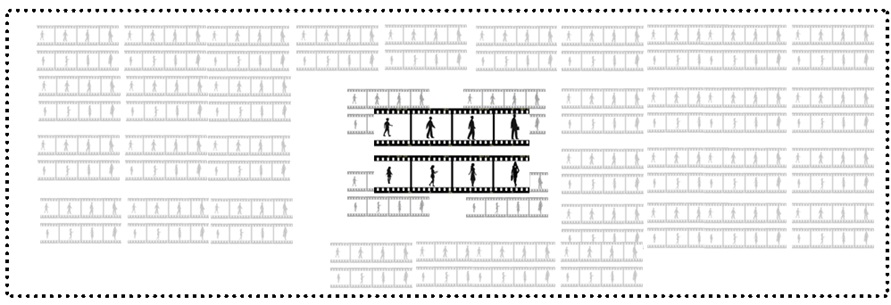In this issue:
Spiritual traditions have always used the circumstances of their time and place to create metaphors meant to convey a dimension of spiritual Reality. From the perspective of the 21st century, a metaphor that I find evocative of one aspect of this Reality is that of film.
Just as our life is a stream of experienced moments, each forever unique in itself, a film is a strip of individual frames, each depicting an event in time. When the film is played continuously at speed, the stream of frames convey an account of relationships and events, i.e., a story. For the purposes of this article, I will use the following strips of “frames” to highlight the stages of a life. Within each stage are the moment-to-moment experiences that are the story of that life. Different cultures will use different representations, but the birth-to-death stages of life are common to all:

And just as the physical film is the vehicle for the story but not the story itself, our body (our skhandas) is the physical means for playing out the story of our life.
In order for a film to be experienced by the senses it must be projected on the reflective surface of a screen. In a sense, it can be said that the story of the film cannot live without the screen. In our film metaphor, the spiritual “screen” on which our life is projected is that greater Reality—immanent and transcendent—in which our life is lived. It is that Reality that is beyond space, time, and concepts and that can only be pointed to via metaphor, symbol, and so on. In the words of the Scripture of Great Wisdom, It is “void, unstained, and Pure.” We will call this fundamental spiritual Reality the Eternal. Since It is unlimited, our limited life takes up only a fraction of the whole, which I will represent like this:

The dotted line is meant to represent the Eternal being unbounded by space and time.
No life is lived in isolation, so an individual life story is overlapped and influenced by others:

Of course, our little circle of stories—while of central importance to ourselves—is only an infinitesimal frame in a story filled with billions of others:

The Eternal “screen” upon which a life story is projected is our spiritual universe, serene and radiant in Itself (“void, unstained, and Pure”). It is unaffected by the scenes of life reflected on It, whether “good” or “bad,” cruel or compassionate, selfish or altruistic…. It hosts everything, and It continues to exist when an individual story stops being projected on it. (As a spiritual metaphor it is perhaps better to say that the story lives in the screen, rather than projected on it.)
If we get right up close to a movie screen we can see that the story that seems so real and multi-dimensional is, in reality, merely fleeting, flickering shadows. Usually we are so caught up in the drama of the story that we do not see the screen hosting the story. It takes a conscious effort of focusing our attention on the screen to see through the shadows to the reality of the screen itself.
In the same way, we are usually so caught up in the dramas of our life that we do not realize the luminous “screen” of the Eternal that life—all life, not just our little human story—is being played out on. We can only know It when we actively shift our perspective from the story of our life to It. And we make that shift by means of meditation and the Precepts. Being beyond words and concepts, the “screen” of the Eternal must be perceived with the heart-mind. Without pure meditation, we cannot see through the shadowy drama of our life to that transcendent Reality beyond it.
What writes the script of our life story that is projected onto the Eternal? Our karma: volitional acts of body, speech, and thought from this life and past lives that planted seeds that are ripening moment-to-moment. And, we have repeated some acts so often that they have generated habit energy that, left unconverted, compels us to repeat them again and again.
Some habits are motivated by forms of greed, anger-aversion, and ignorance of the Eternal. In other words, acts of our self-protecting and self-preserving ego that cause suffering for ourselves and others. That is when our ignorance of Reality is showing. And, we also have times when we act from compassion, love, and the knowledge that all beings share the same Eternal foundation. The more we cultivate that realization by meditation and Precepts the deeper we realize that when we act selfishly and harm others we harm ourselves.
This would be a depressing story if we could do nothing but follow the karmic script and just passively play it out to the end. But because karmic acts are volitional, we can change the script; indeed, we have a responsibility to rewrite it. “It is one’s own doing which reacts on one’s own egocentric self so it is possible for us to direct the course of our karma.”1 So, the very least we can do is to proactively stop indulging in negative, selfish habits and cultivate habits of kindness and compassion that pierce the shadows of our drama.
When a movie ends the screen remains, still pristine and unaffected by the story that has been played out on it. When we realize that the Eternal is the true Reality and the ground of our being and our little drama passing shadows in It, then the words of the Diamond Sutra resonate in us:
Thus should you view this fleeting world:
A star at dawn, a bubble in a stream,
A flash of lightening in a summer cloud,
A flickering lamp, a phantasm, and a dream.
__________________________
Note: the footnote references in the text link to these footnotes. To return to the text, use the Back arrow or button on your browser.
1Rev. Master Jiyu-Kennett,Zen is Eternal Life, p. 9
